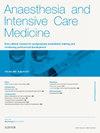剖宫产的区域麻醉,如果麻醉失败怎么办
IF 0.3
Q4 ANESTHESIOLOGY
引用次数: 0
摘要
区域麻醉技术是剖宫产最常用的麻醉方式,主要是因为与孕妇全身麻醉相比,区域麻醉更安全。局部技术的选择受患者和手术因素的影响。对于正在接受抗凝治疗或有凝血异常的患者,区域麻醉的时机是必要的。应提供有关区域麻醉的风险和益处的信息,以促进知情决策。在任何手术产科干预之前,应进行全血细胞计数,分组和保存,并应给予抗酸预防。在分娩前必须保持15°左侧倾斜,同时实施低血压控制策略。在开始手术前,在使用区域麻醉技术后,需要确认足够的麻醉和适当的阻滞高度,并应制定解决区域麻醉潜在失败的计划。剖宫产期间的突破性疼痛是一个重要的问题,必须加以认识和管理。可采用静脉注射速效阿片类药物,而其他镇痛选择包括氧化亚氮、氯胺酮和局部麻醉浸润。如果认为通过这些替代方法不可能有效止痛,则应考虑全身麻醉。术后随访对于发现任何与区域麻醉相关的并发症和确保足够的术后疼痛管理至关重要。本文章由计算机程序翻译,如有差异,请以英文原文为准。
Regional anaesthesia for caesarean birth and what to do if it fails
Regional anaesthetic techniques are the commonest type of anaesthetic for caesarean birth primarily due to their safety profile compared to general anaesthesia in pregnant women. The selection of a regional technique is influenced by both patient and surgical factors. Caution is essential regarding the timing of regional anaesthesia in patients who are receiving anticoagulation or have clotting abnormalities. Information on the risks and benefits of regional anaesthesia should be provided to facilitate informed decision-making. Prior to any operative obstetric intervention a full blood count, group and save should be performed and antacid prophylaxis should be administered. A 15° left lateral tilt must be maintained until delivery along with implementation of strategies to manage hypotension. Confirmation of adequate anaesthesia and appropriate block height is required following the administration of the regional technique before initiating the surgery and plans for addressing potential failures of regional anaesthesia should be established. Breakthrough pain during the caesarean birth is a significant concern that must be recognized and managed. Intravenous fast-acting opioids may be employed, while other analgesic options include nitrous oxide, ketamine, and local anaesthetic infiltration. If effective analgesia is deemed unlikely through these alternative methods, general anaesthesia should be considered. Postoperative follow-up is crucial for identifying any complications related to regional anaesthesia and ensure sufficient postoperative pain management.
求助全文
通过发布文献求助,成功后即可免费获取论文全文。
去求助
来源期刊

Anaesthesia and Intensive Care Medicine
ANESTHESIOLOGY-
CiteScore
0.50
自引率
0.00%
发文量
152
期刊介绍:
Anaesthesia and Intensive Care Medicine, an invaluable source of up-to-date information, with the curriculum of both the Primary and Final FRCA examinations covered over a three-year cycle. Published monthly this ever-updating text book will be an invaluable source for both trainee and experienced anaesthetists. The enthusiastic editorial board, under the guidance of two eminent and experienced series editors, ensures Anaesthesia and Intensive Care Medicine covers all the key topics in a comprehensive and authoritative manner. Articles now include learning objectives and eash issue features MCQs, facilitating self-directed learning and enabling readers at all levels to test their knowledge. Each issue is divided between basic scientific and clinical sections. The basic science articles include anatomy, physiology, pharmacology, physics and clinical measurement, while the clinical sections cover anaesthetic agents and techniques, assessment and perioperative management. Further sections cover audit, trials, statistics, ethical and legal medicine, and the management of acute and chronic pain.
 求助内容:
求助内容: 应助结果提醒方式:
应助结果提醒方式:


